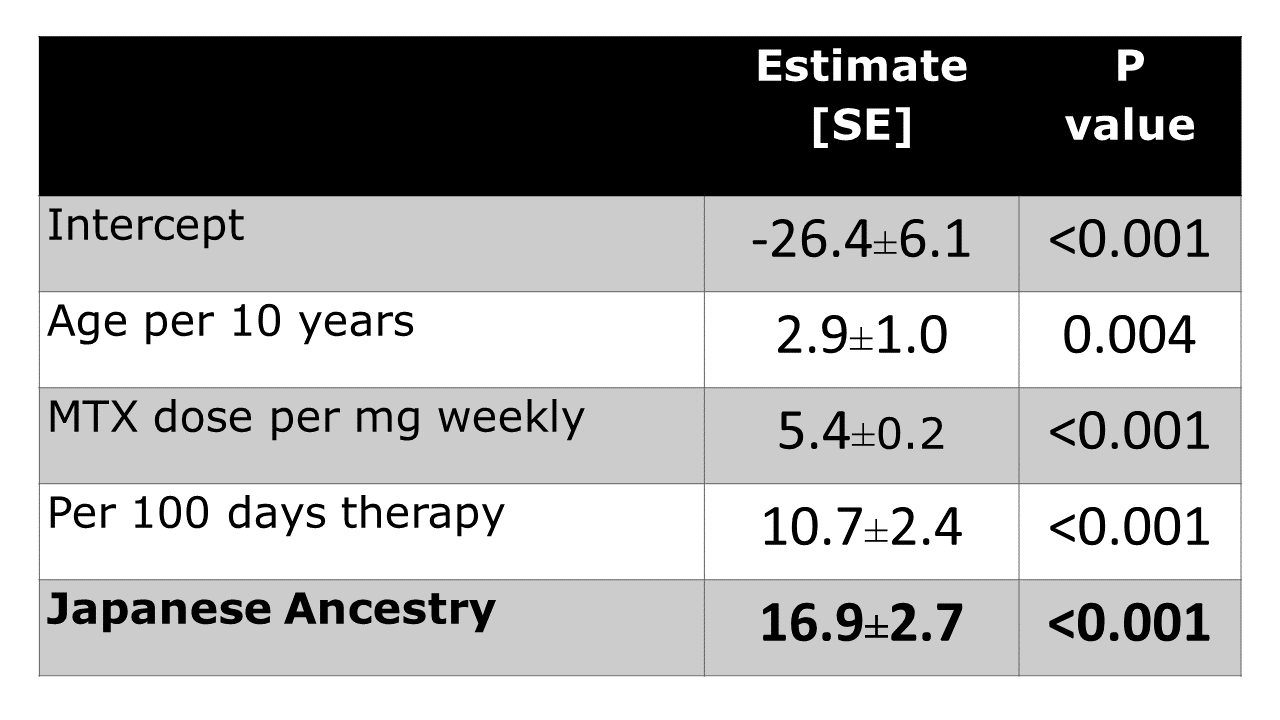Session Information
Session Type: Poster Session (Tuesday)
Session Time: 9:00AM-11:00AM
Background/Purpose: Methotrexate (MTX) is an anti-folate prodrug activated to MTX polyglutamates (MTXPGs). Japanese Rheumatoid Arthritis (RA) patients are thought to have heightened sensitivity to MTX and guidelines have recommended lower MTX doses in that group of patients as compared to Caucasians. We evaluated the impact of ancestry on the accumulation of MTXPG and the effect of these metabolites on disease control.
Methods: Two cohorts of consented adult RA patients naïve to MTX and scheduled to start oral MTX for their treatment were analyzed. All patients fulfilled the 1987 or 2010 ACR criteria for RA. The first cohort consisted of 48 Caucasians from New York State (73% females, mean age: 56±2 years, mean body mass index [BMI]: 28.6±0.1 kg/m2). The second cohort consisted of 58 Japanese from the Tokyo metropolitan area (88% females, mean age 57±2 years, BMI=21.9±0.4 kg/m2). MTX was started at 7.5-8 mg/weekly (with daily folic acid) and escalated every 4 weeks over 4 months, not to exceed 16 mg/week in Japanese RA. Accumulation of MTXPG metabolites was assessed using total red blood cells (RBCs) MTXPG1-5 (1 to 5 order of glutamic residue) expressed as nmol/L packed RBCs. MTXPG were measured using liquid chromatography in a central laboratory. Serum transaminases were also collected. All clinicians were blinded to MTXPG levels during clinical assessments. Disease activity was assessed using Disease Activity Score in 28 joints (DAS 28). Group comparisons used Wilcoxon’s test. Linear mixed effect with random intercept and fixed slope were used to assess the impact of ancestry on MTXPG accumulation and the effect of these metabolites on disease control.
Results: After 3 months therapy similar MTX dosages were administered in the Japanese and Caucasian cohorts (mean 12±3 [SEM] and 12±2 mg/week, respectively; p=0.65). Japanese ancestry associated with higher RBC MTXPG1-5 levels (mean 91±28 [SD] nmol/L) as compared to Caucasian ancestry (mean 61±24 nmol/L) (p< 0.01). This heightened RBC MTXPG1-5 accumulation among Japanese remained significant (estimate 16.9±2.7 nmol/L; p< 0.001) after adjusting for MTX dosage, age, duration of MTX therapy (Table) (Marginal R2=71%). Caucasian patients presented with higher DAS28 at baseline (5.1±0.1 points) than Japanese patients (3.5±0.1 points) (p< 0.001). Higher DAS28 at baseline associated with higher disease activity at follow-ups (estimate=0.66±0.04; Marginal R2=0.38). Heightened RBC MTXPG1-5 levels associated with lower DAS28 by univariate analysis (estimate=-1.6±0.1 point per 100 nmol/L; p< 0.001; Marginal R2=0.19) and the impact of the levels on disease control remained significant (estimate=-0.9±1.4 point per 100 nmol/L; p< 0.001) after adjusting for baseline DAS28 and duration of MTX therapy (Marginal R2=0.57). Higher RBC MTXPG1-5 accumulation also associated with elevated serum transaminases (estimate=4.8±0.1 and 10.0±1.9 units per 100 nmol/L MTXPG1-5 for AST and ALT, respectively) (Marginal R2=0.04 each) (p< 0.001).
Conclusion: MTXPG accumulation differs with ancestry. Japanese RA patients present with enhanced MTX polyglutamation as compared to Caucasians.
To cite this abstract in AMA style:
Dervieux T, Kremer J, Brady K, Takahashi C, Takeuchi T, Kaneko Y. Enhanced Methotrexate Polyglutamation in Japanese as Compared to Caucasian Rheumatoid Arthritis Patients Starting Methotrexate [abstract]. Arthritis Rheumatol. 2019; 71 (suppl 10). https://acrabstracts.org/abstract/enhanced-methotrexate-polyglutamation-in-japanese-as-compared-to-caucasian-rheumatoid-arthritis-patients-starting-methotrexate/. Accessed .« Back to 2019 ACR/ARP Annual Meeting
ACR Meeting Abstracts - https://acrabstracts.org/abstract/enhanced-methotrexate-polyglutamation-in-japanese-as-compared-to-caucasian-rheumatoid-arthritis-patients-starting-methotrexate/

